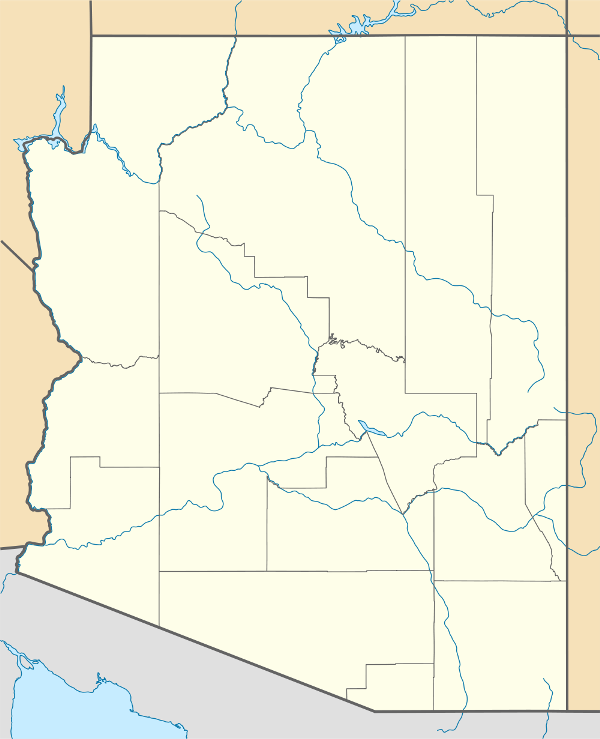Politics of the State of Arizona
| This article is under construction. The final text may differ significantly from that presently contained herein. |
 | |
| State type |
Unitary presidential constitutional republic |
|---|---|
| Constitution | Arizona State Constitution, 1722 |
| Formation | 14 February 1612 |
| Website | link://arizona.gov |
| Legislative branch | |
| Name | Arizona State Legislature |
| Type | Bicameral |
| Meeting place | Arizona State Capitol |
|
Upper house | |
| Name | Senate |
| Presiding officer |
Karen Fann, President of the Senate |
|
Lower house | |
| Name | House of Representatives |
| Presiding officer |
Rusty Bowers, Speaker of the House of Representatives |
| Executive branch | |
|
Head of State and Government | |
| Title | Governor |
| Currently | Manuel Serrano |
|
Cabinet | |
| Name | Arizona State Executive Cabinet |
| Current cabinet | 1st Serrano Executive |
| Leader | Governor |
| Appointer |
Governor with Senate advice and consent |
| Headquarters | Arizona State Capitol |
| Ministries | 31 |
| Judicial branch | |
| Name | Arizona State Courts |
| Chief Justice | Scott Bales |
| Courts | |
 |
| This article is part of the series: Politics and government of the State of Arizona |
|
Executive
|
|
Legislature
|
|
Federal relations
|
XXXX
State government[edit | edit source]
Arizona is a unitary constitutional presidential republic, whereby the Sovereignty of the State is vested exclusively in the People of Arizona. All political Power emanates from the People of Arizona: In Arizona, Government operates, and does so in such form, by the Consent of the Governed; the People, as the sole Sovereign of the State, delegate the exercise of their sovereign Powers to representatives they elect, and these elected representatives govern them on their behalf, in their name, and with their Consent.
As best stated in the Arizona Constitution,
| “ | All political power is inherent in the people, and governments derive their just powers from the consent of the governed, and are established to protect and maintain individual rights | ” |
| —Arizona Constitution, article II, section 2 | ||
The powers of the Government of Arizona are separated into three distinct departments: legislative Power is vested in the bicameral Arizona State Legislature; Powers of an executive nature are vested in the Governor; and those of a judicial nature are vested in the Arizona State Courts. No department may assume or exercise any Power or Powers properly belonging to any of the other departments. Together, the three departments —legislative, executive, and judicial— work to carry on the government of the State. This concept is known as separation of powers.
Legislative department[edit | edit source]
The Arizona State Legislature is bicameral and consists of a thirty (30) Member upper house styled Senate and a sixty (60) Member lower house styled House of Representatives. The Senate is composed of between one (1) and three (3) Senators from each County, reckoned by population, chosen by the Electorate thereof. On the other hand, the House of Representatives consists of sixty (60) Members (Representatives), with two (2) Representatives chosen in each of the thirty (30) Legislative Districts by the resident Electors thereof. The Term for Senators is six Years, and the Term of Representatives is two. However, while all sixty (60) Seats in the House of Representatives are filled every two Years, elections for the Senate, on the other hand, are staggered where the Seats of one-third of the Senate (10 Seats) are filled by election every two Years.
Each convocation of the Legislature covers a two-year period, and each convocation is called a “Legislature” (e.g., the first convocation of the Legislature is called the 1st Arizona State Legislature, while the centennial convocation is the 50th Arizona State Legislature). The first session following the general election is known as the first regular session, and the session convening in the second year is known as the second regular session. Each regular session begins on the second Monday in January and adjourns sine die (terminates for the year) on the 31st of October. The President of the Senate and Speaker of the House, by rule, may extend the session up to seven additional days. Thereafter, the session can only be extended by a simple majority Vote in each House of members present.
Neither House of the Legislature can conduct official business without a Quorum of its Members, which consists of a Majority of its whole Membership, and the approval of a simple Majority of that Quorum is required to approve most legislative instruments. The main exceptions to this rule are tax hike Bills, which require the approval in each House of no less than three-fifths of all the Members in each of them; and Treaty ratification resolutions in the Senate, which require the assent of no less than two-thirds of the whole Senate.
Senate[edit | edit source]
The Arizona State Senate is the upper house of the Arizona State Legislature. It is composed of thirty (30) Senators, apportioned among the fifteen (15) Counties of Arizona, where the voters in each County choose between one and three Senators to represent them in the Senate for six Years (more populous Counties choose more Senators); and the seats of one-third of the Senate (10 seats) are filled by election every two Years.
The Senate is a more collegial body than the House of Representatives, and it also operates at a much more relaxed pace compared to the House. In addition, the Senate is vested with certain Powers that the House of Representatives does not have: For instance, while the Governor nominates Persons to fill senior executive offices (e.g., offices not included within the civil service), he cannot install them in office unless the Senate give their Advice and Consent to the appointment. Furthermore, all appropriations bills must originate in the Senate (but the House of Representatives may concur or propose amendments, as on other bills). In addition, similar to the case of gubernatorial appointments, the Governor has the Power to sign Treaties with other States (including foreign States), the Senate must give their Advice and Consent for the Treaty to be ratified and enter into force; and finally, while the Power of Impeachment lies with the House of Representatives, the Power to remove civil and military Officers for Impeachment rests with the Senate alone (Impeachment is similar to the empaneling of a Grand Jury, and a successful Impeachment is akin to a Grand Jury returning an Indictment; while the Senate acting on the Impeachment to remove an official is similar to a Trial).
The Head of the Senate is their President, who is appointed by the Governor on the recommendation of the whole Senate, for the duration of the Term of Office of the appointing Governor; upon the inauguration of a new Governor, the process to choose a new President of the Senate begins anew. In addition to being the head of the Senate, the President, as first in line to the Governorship, serves as Acting-Governor (“Governor pro Tempore” as styled in the Arizona State Constitution) whenever the elected Governor is absent from the State or is otherwise unable to discharge the Powers and Duties of his Office. In the event that the elected Governor dies in Office, resigns, or is removed from Office, the President of the Senate becomes Acting-Governor for the remainder of the Term of the previously elected Governor. The President of the Senate is assisted by the President pro Tempore, who deputizes in his absence, or when he exercises the Powers and Duties of the Office of Governor, or otherwise succeeds to that Office.
House of Representatives[edit | edit source]
The Arizona House of Representatives is the lower house of the Arizona State Legislature. Like the Senate, the House is a directly-elected body; however, Members of the House of Representatives are chosen from among the thirty State legislative Districts, where the electors in each District send two (2) Representatives to speak on their behalf for two Years in the House of Representatives, for a total of sixty (60) Representatives. Unlike the Senate, all sixty (60) seats in the House of Representatives are chosen at the same time every two Years.
The Head of the House of Representatives is their Speaker, who is chosen by the whole House by exhaustive ballot, for the duration of the Legislature (each Legislature lasts two Years). He is assisted by the Speaker pro Tempore, who deputizes in his absence, or when he exercises the Powers and Duties of the Office of Governor, or otherwise succeeds to that Office.
Executive department[edit | edit source]
All executive Power of the State is vested in the Governor. The Governor is both chief of state and head of the executive department, as well as commander-in-chief of all military and state police forces (“security forces”) of the State of Arizona. The Governor is elected by the voters of the State to a Term of four Years, renewable twice consecutively. Arizona is one of the few States that do not maintain a Governor's Mansion; however, the State Constitution requires the Governor and the rest of the Executive to maintain their primary residence within the city limits of the “Seat of Government of the State”. While in Office, the Governor maintains his office at the Arizona State Capitol, but continues to reside within his private residence, provided such residence is within the Phoenix city limits: If he is not domiciled in the State capital, then he must, before he takes office, establish primary residence within the City of Phoenix or forfeit his Commission as Governor. For the rest of the Executive, Members thereof must establish primary residence within the Seat of the Government of the State within two Months of taking office or forfeit their Commission).
XXXX
Judicial department[edit | edit source]
The judicial department of the State consists of an integrated department overseen by the Arizona supreme Court. Judges are appointed by the Governor from a list prepared by either the Arizona Commission on Appellate Court Appointments (for Judges of the Arizona supreme Court and the Arizona Court of Appeal) or the Arizona Commission on Trial Court Appointments (for Judges of the Arizona superior Court), to a nominal Term of four Years; and each of them in their third Year are subject to a retention vote in which the voters of the jurisdiction in and for which they serve are asked whether to retain that Judge for another Term of four Years: If the Voters chose to retain him for another Term, he remains in office for said Term, and an election for that seat is not called; but if the Voters choose not to retain him for another Term, in the following Year the relevant judicial nominating commission prepares a new list from which the Governor selects a replacement for the outgoing Judge, who serves for a Term of four Years in his own right; and the process repeats as Necessary. Furthermore, Judges, like Senators, Representatives, and the Governor, are also subject to the recall Power of the People.
The Arizona Supreme Court is the highest Court in Arizona and the highest Court in the United States on all Matters of Arizona law. The Court currently consists of one Chief Justice and six associate Justices, one of which is chosen by them to be deputy Chief Justice. Justices are appointed by the Governor from a list prepared by the Arizona Commission on Appellate Court Appointments to a Term of four Years, and each of them in their third Year are, respectively, subject to a retention vote and every four Years thereafter. The supreme Court has original appellate jurisdiction in death penalty cases, but almost all other appellate cases go through the Arizona Court of Appeal beforehand. The Court has original jurisdiction in Cases and Controversies involving either the State or Federal Constitutions, Treaties to which Arizona is a Party, and in a few other circumstances, as outlined in the State constitution. The Court may also declare laws unconstitutional, but only while seated en banc. Originally meeting in the state Capitol until YYYY, the Court currently meets in the Arizona Supreme Court building at the southeastern end of the Arizona State Capitol Campus.
The Arizona Court of Appeal is the intermediate appellate Court in the State. The fifteen Judges of the Court of Appeal are appointed by the Governor in the same Manner as Justices of the supreme Court. The Governor designates one of the Judges of the Court of Appeal as Chief Judge for a Term of five Years; whereas the deputy Chief Judge is chosen by and from among the fifteen Judges to a Term conterminous with that of the Chief Judge. The Term of Office of a Judge of the Court of Appeal is four Years, and each of them in their third Year are, respectively, subject to a retention vote and every four Years thereafter.
- Main articles: Superior Court of Arizona (by division)
The general jurisdiction and general trial-level Court in Arizona is the Arizona Superior Court. The Superior Court is organized as a single entity with fifteen divisions, in which the geographic boundaries of each division are conterminous with each of the fifteen counties of Arizona; however, the size and organization of each division vary and generally depend on the size and population of each particular county. Judges of the Superior Court are appointed by the Governor from a list prepared by the Arizona Commission on Trial Court Appointments, to a Term of four Years; and in their third Year are subject to a retention vote and every four Years thereafter.
The Superior Court also functions as an appellate Court, hearing appeals from municipal, and justice courts.
XXXX
Political subdivisions[edit | edit source]
XXXX
Counties[edit | edit source]
According to the Arizona Constitution, counties are “political subdivisions of [the] State that exist to aid in the administration of [the] laws of the State and for purposes of self-government” (Arizona Const., article XII, section 7). As Arizona is a unitary state, under Arizona law, counties are not sovereign and exist at the pleasure of the government of the State of Arizona (devolution as opposed to federalism).
Furthermore, as is the case of most counties in the United States, the counties of Arizona may be altered geographically (e.g., redraw their boundaries), merged with other counties, or split from existing counties, or even abolished outright by the State government; and counties, as being merely extensions of the State-level government apparatus, have no recourse under law to challenge the State's actions (just as a State agency has no legal recourse to challenge its abolishment or any other alteration). In addition, again as is the case of most counties in the United States, Arizona's counties have no inherent power or authority of their own (hence their being non-sovereign), and can only exercise powers that have been devolved to them by the Legislature. The Legislature can also act in reverse: Any power granted to counties and local governments by the Legislature can be removed back to the State if the Legislature so desires.
Cities and towns[edit | edit source]
XXXX
Law and liberties[edit | edit source]
Arizona Constitution[edit | edit source]
XXXX
Arizona Revised Statutes[edit | edit source]
XXXX
Law enforcement[edit | edit source]
Arizona State Troopers[edit | edit source]
XXXX
Sheriffs[edit | edit source]
XXXX
Local police[edit | edit source]
XXXX
Special law enforcement agencies[edit | edit source]
XXXX
Courts[edit | edit source]
XXXX
Corrections[edit | edit source]
XXXX
Military Department[edit | edit source]
XXXX
Homeland security and emergency management[edit | edit source]
XXXX
Political culture[edit | edit source]
XXXX
Elections[edit | edit source]
XXXX






